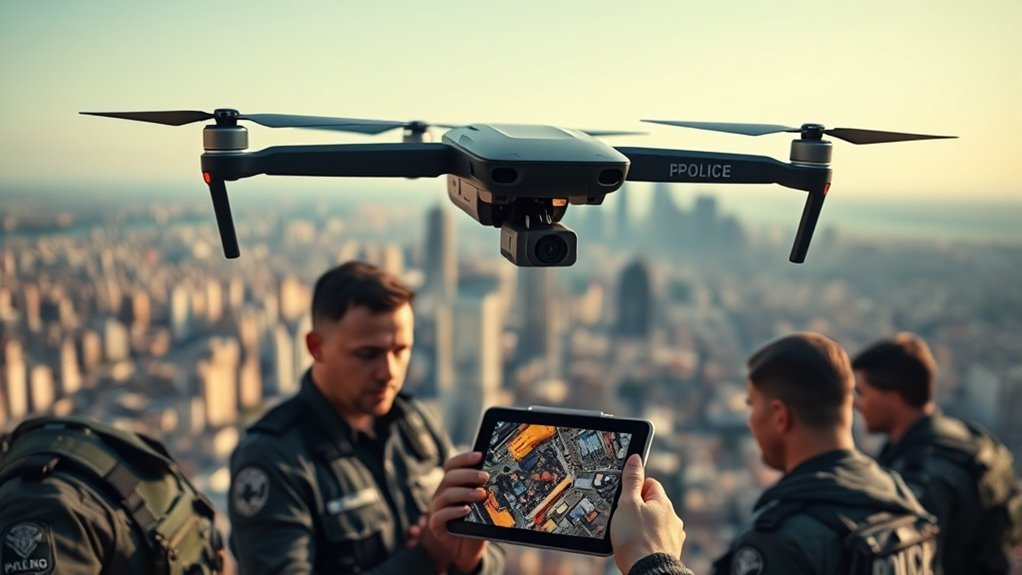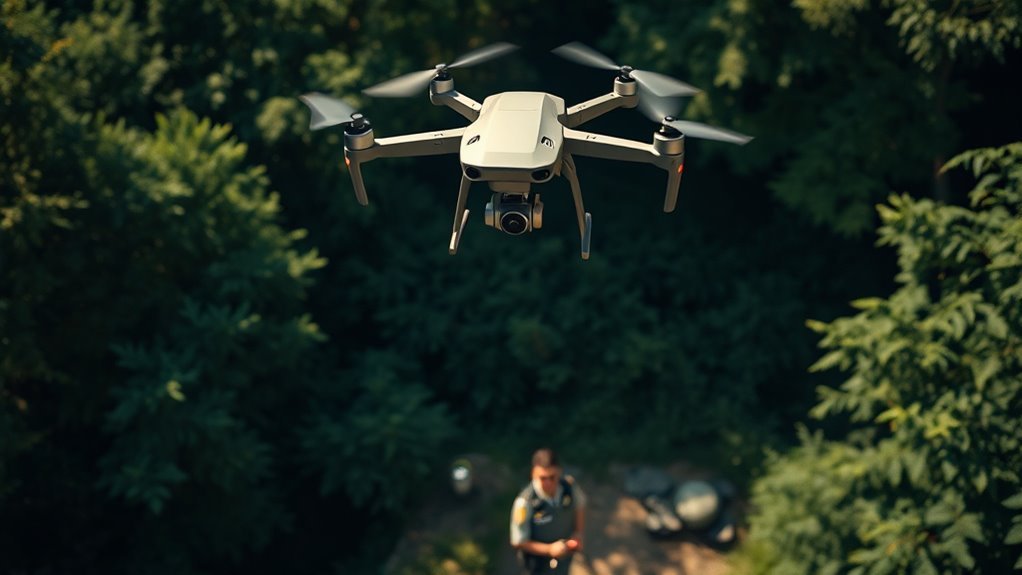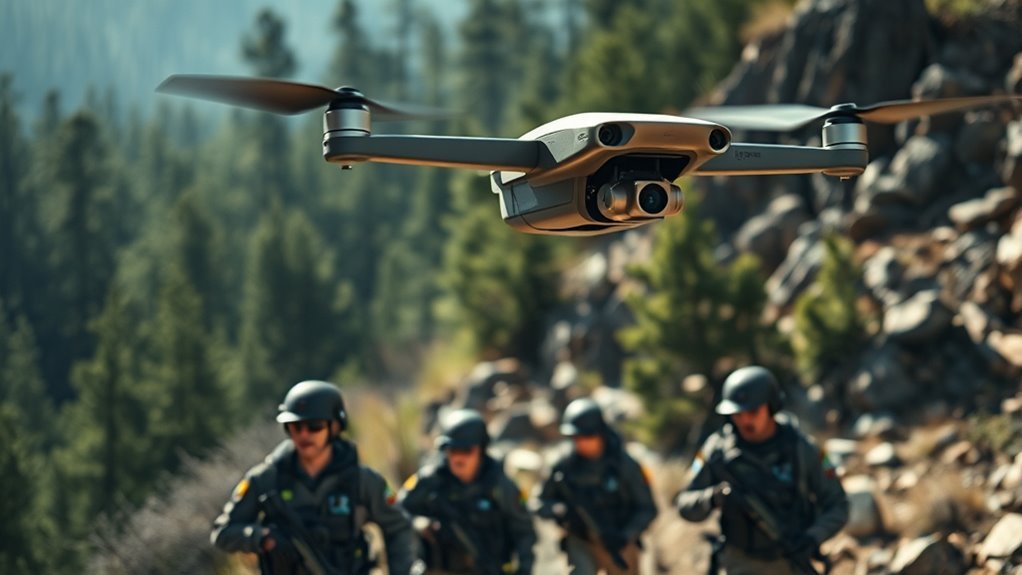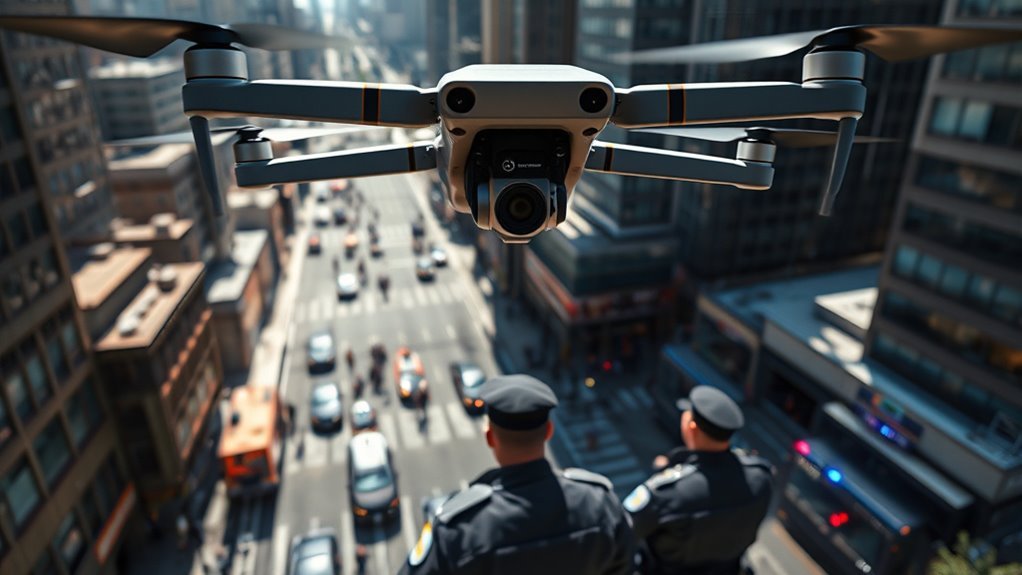Law enforcement uses drones to enhance operational efficiency, improve situational awareness, and gather real-time information. These aerial devices offer capabilities like surveillance, thermal imaging, and rapid data collection, helping in search and rescue, crowd control, and traffic management. Drones enable officers to cover extensive areas quicker than traditional methods, providing valuable insights while maintaining communication with command centers. Understanding their role reveals important insights about privacy concerns and future advancements in policing technology.
Overview of Drone Technology in Law Enforcement

As law enforcement agencies increasingly adopt advanced technologies, drones have emerged as a transformative tool for enhancing operational efficiency and situational awareness. These aerial devices offer a unique vantage point, enabling real-time data collection and analysis. However, with these technological advancements come drone regulations that must be navigated carefully. Compliance with federal and state laws is vital to guarantee responsible use while maintaining community trust. Drones can streamline operations in various scenarios, from search and rescue missions to traffic monitoring. By integrating drones into their arsenal, law enforcement agencies can leverage precise aerial insights, ultimately improving public safety. Yet, as you embrace these innovations, it is important to remain mindful of the legal frameworks governing their use to protect individual freedoms.
Surveillance and Monitoring Capabilities

While the integration of drones into law enforcement operations enhances surveillance and monitoring capabilities, it also raises important considerations regarding privacy and ethical use. The application of drone technology can greatly improve situational awareness through:
- Real-time video feeds: Enabling officers to assess incidents as they unfold.
- Thermal imaging: Assisting in locating individuals in low-visibility conditions.
- Data collection: Gathering intelligence on crime patterns and hotspots.
- Extended range: Covering large areas quickly, which traditional methods can’t achieve.
However, the use of drones must balance surveillance benefits with the protection of civil liberties, ensuring that monitoring doesn’t infringe on individual rights. Law enforcement agencies must implement clear policies to govern the ethical deployment of drone technology.
Search and Rescue Operations

When a person goes missing, the timely deployment of drones can greatly enhance search and rescue operations. Drone applications enable law enforcement to cover vast areas quickly, utilizing high-resolution cameras and thermal imaging to locate individuals in challenging terrains. This technology markedly boosts rescue efficiency, reducing the time it takes to find missing persons. Drones can access hard-to-reach locations that might hinder ground teams, allowing for a broader search radius. Additionally, real-time data transmission keeps command centers informed, facilitating strategic decision-making. By integrating drone technology into search efforts, law enforcement not only increases the chances of successful rescues but also respects individual freedoms by minimizing invasive ground searches. This innovative approach exemplifies the evolving role of technology in public safety, as thermal imaging plays a crucial role in detecting heat signatures from afar, significantly enhancing responder capabilities in locating individuals.
Crowd Control and Event Management
In managing large gatherings, drones can provide real-time aerial monitoring, allowing law enforcement to assess crowd dynamics effectively. This capability enhances public safety by enabling quick responses to potential disturbances or emergencies. As you consider the implications of drone technology in event management, it is crucial to evaluate both its benefits and potential challenges.
Monitoring Large Gatherings
As large gatherings become increasingly common, law enforcement agencies are turning to drones for effective crowd control and event management. Drones provide real-time aerial surveillance, enhancing event security while respecting individual freedoms. They allow officers to monitor crowd behavior from above, aiding in quick decision-making.
Key advantages of using drones include:
- Real-time monitoring: Instantaneous feedback on crowd density and movement.
- Situational awareness: Enhanced visibility to identify potential issues before they escalate.
- Resource allocation: Efficient deployment of personnel based on drone observations.
- Reduced risks: Minimizing the need for ground units in sensitive areas, preserving public safety.
Incorporating drones into monitoring strategies allows for a proactive approach to managing large gatherings effectively.
Enhancing Public Safety
The integration of drones into event management not only enhances monitoring capabilities but also greatly improves public safety. By leveraging aerial surveillance, law enforcement can quickly assess crowd dynamics, identify potential hazards, and respond proactively. The drone benefits include real-time data collection and analysis, which aids in ensuring community safety. You can observe how drones can monitor large areas effectively, providing insights that ground personnel may miss. In emergencies, drones facilitate rapid communication and coordination, allowing for swift deployment of resources, ultimately minimizing risks to attendees. As the technology evolves, it offers a more efficient way to maintain order and enhance the overall experience, promoting a secure environment where freedom can thrive without compromising safety.
Traffic and Accident Management
While traversing the complexities of traffic incidents, law enforcement agencies increasingly rely on drones to enhance their response capabilities. These unmanned aerial vehicles play an essential role in improving traffic monitoring and accident prevention.
Here are four key functions they perform:
- Real-Time Traffic Monitoring: Drones provide live feeds, allowing officers to assess conditions quickly.
- Accident Scene Assessment: They capture aerial views, helping to understand the scale and impact of incidents.
- Crowd Management: Drones can monitor large gatherings, ensuring smooth traffic flow.
- Data Collection: They gather critical information that aids in future traffic safety measures.
Evidence Gathering and Crime Scene Investigation
In evidence gathering and crime scene investigation, drones offer advanced aerial photography techniques that enhance situational awareness. You can capture high-resolution images and videos, allowing for a thorough analysis of the scene from multiple angles. This capability not only aids in documentation but also assists in identifying vital evidence that may not be visible from ground level.
Aerial Photography Techniques
Aerial photography techniques have revolutionized evidence gathering and crime scene investigation, offering law enforcement an efficient means to capture expansive views of crime scenes. Utilizing drone photography methods enhances the capability to document critical details from various angles. Here are four key advantages:
- Wide Coverage: Easily capture large areas that ground personnel may miss.
- High Resolution: Acquire detailed aerial imagery techniques that reveal subtle evidence.
- Real-Time Data: Provide immediate insights for tactical decision-making during investigations.
- Safety: Reduce risks to personnel by surveying hazardous locations from the air.
These advancements empower law enforcement to conduct thorough investigations while ensuring the integrity and accuracy of the evidence collected. Embracing these technologies promotes a more liberated approach to crime scene analysis.
Enhanced Scene Analysis
As law enforcement agencies increasingly adopt drone technology, enhanced scene analysis becomes an essential component of modern evidence gathering and crime scene investigation. Drones facilitate real-time assessments, allowing officers to gather data rapidly and efficiently. By providing multi-angle perspectives, they enable law enforcement to analyze complex scenes from various heights and orientations, revealing vital details that may be overlooked from the ground. This aerial advantage supports the identification of evidence, victim locations, and potential escape routes. Furthermore, the ability to capture high-resolution imagery and video enhances documentation, ensuring that all aspects of the scene are preserved for future analysis. Ultimately, this technology not only streamlines investigations but also upholds the integrity of the evidence collected, fostering a more transparent judicial process.
Supporting SWAT and Tactical Operations
While tactical operations often involve high-stakes scenarios that require swift decision-making and precise execution, drones have emerged as invaluable tools for SWAT teams. They offer significant tactical support, enhancing operational efficiency in various ways:
Drones are revolutionizing SWAT operations, providing critical support for real-time surveillance and risk mitigation.
- Real-time Surveillance: Drones provide live feeds, allowing SWAT teams to assess situations without exposing themselves to danger. Their capabilities mirror autonomous navigation seen in advanced delivery drones, enhancing their effectiveness in dynamic environments.
- Intelligence Gathering: They can collect data on suspect locations and movements, which aids in formulating effective tactical plans.
- Communication: Drones facilitate better communication between team members and command centers, ensuring everyone’s on the same page.
- Risk Mitigation: By using drones, teams can reduce risks to officers and civilians during high-risk operations.
Additionally, real-time data analytics empowers teams to make informed decisions swiftly, improving overall operational effectiveness.
Incorporating these technologies optimizes tactical support, ultimately leading to more effective outcomes.
Community Engagement and Outreach
The integration of drones in law enforcement expands beyond tactical operations, offering innovative avenues for community engagement and outreach. By fostering community partnerships, law enforcement can utilize drones to enhance transparency and build trust with the public. Drones serve as valuable tools for public education, demonstrating their role in safety and crime prevention during community events. For example, aerial demonstrations can illustrate how drones are deployed in search and rescue missions, thereby enhancing community awareness of police capabilities. Additionally, engaging citizens in discussions about drone use can alleviate concerns and encourage collaboration. Proactive vulnerability identification ensures that the use of drones is secure and minimizes risks, reinforcing the commitment to community involvement and safety. By prioritizing these initiatives, law enforcement agencies can reinforce their commitment to community involvement, ensuring that the adoption of drone technology aligns with public interests and values. Furthermore, drones can provide real-time aerial surveillance capabilities that allow law enforcement to assess situations swiftly and effectively during community events, enhancing overall safety and responsiveness.
Challenges of Privacy and Civil Liberties
As law enforcement increasingly employs drones, significant concerns about surveillance and data collection arise. You need to reflect on how these practices impact individual privacy and the necessary accountability measures that should be in place. Addressing these challenges is essential for maintaining civil liberties in an age of advanced technology.
Surveillance Concerns
Given the increasing prevalence of drone technology in law enforcement, concerns about surveillance practices and their implications for privacy and civil liberties have emerged as critical issues. As you consider these developments, it’s essential to reflect on several factors that influence public perception and raise significant privacy implications:
- Data Collection: Drones can capture detailed images and data without consent.
- Targeting: There’s potential for discriminatory surveillance based on race or socioeconomic status.
- Lack of Regulation: Insufficient oversight may lead to abuse and overreach by law enforcement.
- Chilling Effect: Citizens might alter their behavior, fearing unwarranted surveillance.
These challenges necessitate a careful examination of how drone use intersects with your rights and freedoms. Balancing security and civil liberties is crucial in this evolving landscape.
Data Collection Policies
While drone technology offers law enforcement enhanced capabilities for data collection, it simultaneously raises significant challenges regarding privacy and civil liberties. You might question how data retention policies are formulated and enforced, especially when they intersect with individual rights. Without clear policy guidelines, the potential for misuse escalates. Surveillance could extend beyond its intended purpose, leading to an erosion of trust in law enforcement. Furthermore, the ambiguity surrounding data retention can result in the unnecessary accumulation of personal information, infringing on your privacy. Consequently, as drone deployment expands, it’s vital that robust data collection policies are established to protect civil liberties, ensuring that the balance between security and personal freedom is maintained. Your rights should never be compromised in the name of safety.
Accountability Measures Needed
Although the deployment of drones in law enforcement can enhance operational efficiency, it simultaneously necessitates stringent accountability measures to safeguard privacy and civil liberties. To guarantee these measures are effective, consider the following:
- Transparency Initiatives: Implement clear guidelines on drone usage and data collection.
- Public Oversight: Establish independent review boards to monitor drone activities and address community concerns.
- Data Retention Policies: Define strict limits on how long data collected can be stored to prevent misuse.
- Community Engagement: Foster ongoing dialogue between law enforcement and the public to build trust and guarantee accountability.
Future Trends in Drone Usage for Policing
As technology continues to evolve, the integration of drones into law enforcement is poised to transform policing practices considerably. Future innovations, like enhanced AI capabilities and real-time data analytics, will enable more precise surveillance and quicker response times. However, regulatory developments will also shape these advancements, ensuring that civil liberties are protected. The potential for real-time monitoring will enhance situational awareness for officers in the field, as drones equipped with AI-driven obstacle avoidance can navigate complex environments safely.
| Trend | Description |
|---|---|
| AI-Driven Surveillance | Drones using AI for real-time threat detection. |
| Enhanced Training | Officers receiving specialized training in drone operations. |
| Community Engagement | Increased transparency via community involvement in drone policies. |
| Data Privacy Protections | Stricter regulations to safeguard citizen data. |
| Remote Operations | Drones facilitating remote policing in difficult terrains. |
These trends suggest a future where drones enhance policing while balancing freedom and safety.
Frequently Asked Questions
How Are Drones Operated by Law Enforcement Officers?
Drones operate under strict operational protocols, utilizing advanced drone technology for surveillance and data collection. You’ll find officers trained to navigate these devices efficiently, balancing public safety with maintaining citizens’ rights and privacy.
What Are the Costs Associated With Drone Usage in Policing?
When evaluating costs associated with drone usage in policing, you’ll need a thorough cost analysis, considering initial purchase, maintenance, training, and operational expenses. Budget considerations are essential to guarantee effective and responsible deployment without financial strain.
Are There Regulations Governing Police Drone Usage?
About 60% of Americans oppose police drone usage due to privacy concerns. Regulations do exist to address drone privacy and public perception, ensuring law enforcement balances operational needs with citizens’ rights and freedoms effectively.
How Do Drones Enhance Officer Safety During Operations?
During operations, drones’ surveillance technology provides real-time intelligence, enhancing officer safety. They offer tactical advantages by evaluating situations from above, reducing risks, and allowing officers to make informed decisions without direct exposure to potential threats.
What Types of Drones Are Commonly Used by Police Departments?
When you think of cutting-edge technology, drones soar as the ultimate eyes in the sky. Police use quadcopters for surveillance capabilities and fixed-wing drones for aerial mapping, enhancing operational efficiency while ensuring public safety and transparency.

